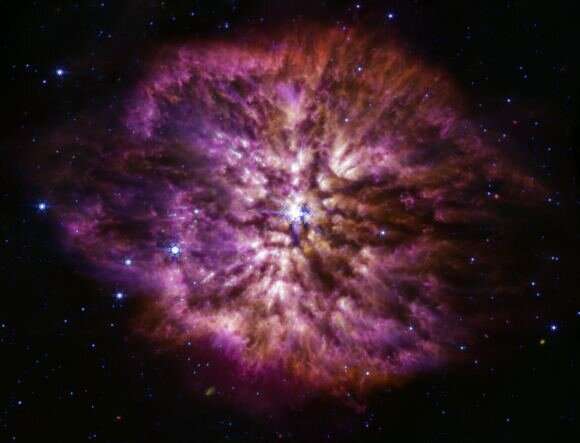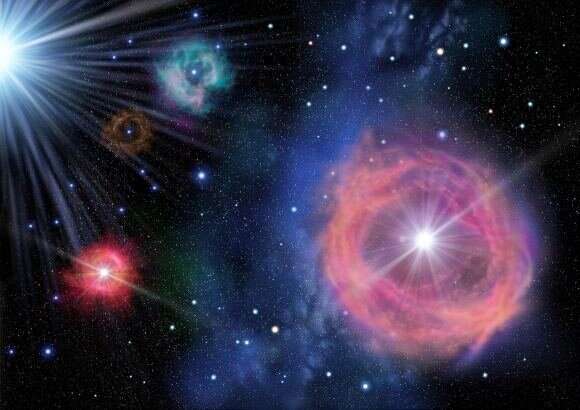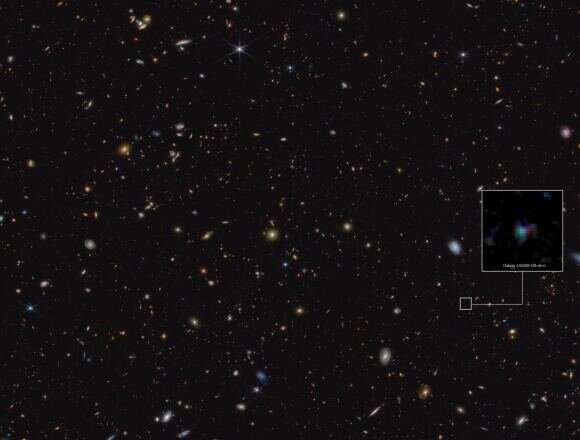This article has been reviewed according to Science X's editorial process and policies. Editors have highlighted the following attributes while ensuring the content's credibility:
fact-checked
trusted source
proofread
Carbon-based molecules seen just a billion years after the Big Bang

The more astronomers look at the early universe, the more discoveries they make. Some of those finds change what they thought they knew about the infancy of the cosmos. For example, the James Webb Space Telescope (JWST) recently found evidence of carbon-based molecules and dust existing only a billion years after the Big Bang. It looks a bit different from the dust observed later in the universe.
JWST's discovery comes from an early galaxy survey called JADES (JWST Advanced Deep Extragalactic Survey). The survey spent 32 days of telescope time observing and characterizing faint early galaxies. The dust it observed was in at least one of those hundreds of galaxies studied. It seems to consist of graphite or diamond-like grains, something we see plenty of in the later stages of cosmic history.
Their chemical signatures look remarkably like carbon-based molecules called "polycyclic aromatic hydrocarbons" (PAH). Those molecules are plentiful later on in the universe, but it's not likely they were around when the universe was only a billion years old. So, how could the doppelgangers of PAH molecules exist so early in history?
Pinning down a source for those carbon-based molecules
Astronomer Joris Witsok, the lead author of a paper describing the discovery, speculated that the diamond-like grains came from the debris ejected in supernova explosions. "This could also potentially be produced on short timescales by Wolf-Rayet stars or supernova ejecta," he explained.

These old, superhot stars may be progenitors of some types of supernova explosions. They'd be the perfect cradles for the creation of nano-diamonds and other carbon-based dust. In fact, some models do show that carbon-rich grains come from certain types of Wolf-Rayet stars. Not only that, but those grains can survive when the stars explode as supernovae.
The next question is whether or not such stars existed in the early universe in order to produce the dust JWST observed. The dust certainly provides tantalizing clues about the earliest stellar populations in the universe. That's because those first stars were massive and did explode as supernovae.
The earliest ones formed when the universe was quite young—maybe as early as a hundred million years after the Big Bang. Certainly, the first galaxies date back to around 400 million years after the Big Bang. The first stars were massive weirdoes made of hydrogen and helium. They lived short, fast lives and exploded as supernovae. Those explosions could have provided the earliest examples of dust in the universe.
With more episodes of star formation in the earliest galaxies, dust accumulated, and that's what JWST detected. Carbon-based molecules and nano-diamonds require specific hot, energetic conditions, which could have been provided by the earliest stars.
Carbon-based molecules and dust
Dust exists throughout the cosmos. Since it's a product of stellar evolution, so it's no surprise to find the stuff in the early universe. It provides insight into stellar processes, but it also hides a lot of things. For example, dust hinders our view of the core of the Milky Way as well as objects in the infant universe. Luckily, there are methods to "see through" it, which is what JWST does.
Chemical analysis of the dust provides minute details about its makeup. Certain dust molecules interact with specific types of light. Astronomers use that property to figure out what the dust is made of. That's what the team led by Witstok did with their JWST observations. "Carbon-rich dust grains can be particularly efficient at absorbing ultraviolet light with a wavelength around 217.5 nanometers, which for the first time we have directly observed in the spectra of very early galaxies," he said, talking about their observation.

The 217.50-nanometer absorption feature is a great tool for observing dust and figures prominently in observations of PAH molecules across the universe. It identifies both PAH molecules as well as nano-sized graphitic grains. It would be cool if PAHs existed early in cosmic history. However, their formation process is more associated with newborn stars and exoplanet formation. They haven't been observed much earlier than about two billion years after the Big Bang. Interestingly, PAHs are also one of the basic chemical building blocks of life.
If not PAH, then what's out there?
Interestingly, the features that JWST saw actually peak at 226.3 nanometers. That's not terribly different from the 217.5 nm measurement, and it might be a measurement error. However, it's also very possible that this minute wavelength difference indicates the composition of early cosmic dust is just slightly different from the dust we see in later epochs. And, that's kind of exciting, according to Witstok. "This slight shift in wavelength of where the absorption is strongest suggests we may be seeing a different mix of grains, for example, graphite- or diamond-like grains," he said. "This could also potentially be produced on short timescales by Wolf-Rayet stars or supernova ejecta."
All of this plays out against a continuing study of early galaxies. Before JWST, astronomers had to image multiple galaxies in the early universe. Repeated observations gave enough information about those early stars and how dust absorption affects their light. However, that restricted observations to galaxies that had been forming stars and dust for a long time. There wasn't much chance to look at younger galaxies and stars to pin down their dust production. JWST allowed observations of individual dwarf galaxies that existed in the first billion years of cosmic time. That gives them a window of time to study the origins of cosmic dust when the universe was really in its infancy.
Of course, there's more work ahead, according to team member Irene Shivaei. "We are planning to work further with theorists who model dust production and growth in galaxies," said Shivaei. "This will shed light on the origin of dust and heavy elements in the early universe."
Provided by Universe Today





















